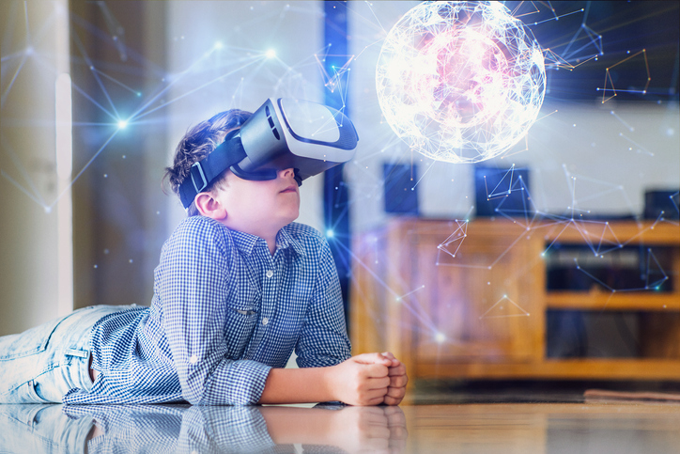Viewing virtual reality of icy landscapes may relieve pain
Immersing people this way in a polar world reduced their pain without using drugs

We often pop a pill to ease a headache. But drugs can have dangerous side effects for people with chronic pain. Virtual reality may offer them a safer, less costly alternative. Researchers immersed people in the icy environment of Antarctica to test this idea.
Photodynamic/iStock/Getty Images Plus
Wearing a headset to play a virtual-reality game is fun. As you move your head around, you can see the scene from different angles. You’re immersed in a fake environment that seems so real. But the power of VR may go well beyond entertainment. It just might help people who suffer from long bouts of pain, a new study finds.
“If VR can reduce some types of pain, it could become a new therapy with fewer side effects than drugs,” says Sam Hughes. “And it would be less expensive.”
Hughes is a psychologist in England, at Imperial College London. His group studies bone and muscle pain. One example is sciatica (Sy-AT-ih-kuh). This lower back pain radiates into the hip and legs. (It’s often caused by a bulging disc in the spine pressing against the sciatic nerve.)
Sciatica is a form of pain that can persist on and off for weeks or even years. Doctors call such persistent pain chronic. It’s different from acute pain. That’s what you feel when you hit your knee against a table or put your hand in very hot water. It’s a fairly short-lived warning to stop this type of action right away.
Chronic pain is not a warning signal. It may even spread from an initial site to other body parts. This was the type of pain Hughes’ group was looking to tackle.
Putting a number on our pain-control system
The researchers started by recruiting 19 healthy people. Each volunteered to accept some form of temporary pain. The first pain came from a special cream applied to the skin. The cream contained capsaicin (Kap-SAY-ih-sin). It’s the chemical in hot chili peppers that burns your mouth.
About one in five people will feel nothing when the pepper cream touches their skin. This was true for four of the recruits. With the other 15, an initial tingling soon became an intense burning. These more sensitive volunteers took part in the rest of the study.
The researchers assessed the volunteers’ pain-control system. That’s located in the brain. The tests used a special device that applied gradual pressure to one arm. The level at which someone first felt pain was their pain pressure threshold, or PPT.
After a short rest, the volunteers had to put their opposite hand in a bucket of icy water. This becomes painful after a few seconds. The researchers again applied pressure to the arm and got a new PPT (while the other arm’s hand stayed in the cold water).
Most people can better tolerate a painful sensation when they experience a second pain at the same time. So that second PPT reading would be higher. The change in the two PPTs is one gauge of how well the pain-control system is working. The researchers wondered if this number could predict whether and how well VR might reduce other types of pain.
Virtual reality and pain perception
To address that question, the tests would have to simulate other types of pain. Hughes describes one such test. The researchers used the pepper cream to model what sunburn does to skin in a short amount of time.
Sunburn makes reddened skin sensitive to heat. “If you take a shower,” Hughes observes, “the water feels hotter than it should.” That’s the acute pain.

But another type of pain can develop near the sunburn. This neighboring skin will react more strongly than normal to a light touch. That’s because the sunburn slightly alters how nerves beneath the skin communicate with the brain. The sensitivity here resembles chronic pain. (Hughes notes that this is not true chronic pain because it lasts only as long as the sunburn.)
Within 45 minutes of applying the pepper cream to a pea-sized circle of skin, the region reddened and turned painful. The volunteers rated that pain on a scale from 0 to 100. A rating of 0 to 5 meant no pain. A score from 40 to 60 indicated moderate pain and levels above 60 more intense pain. The area just outside this circle became more sensitive to other painful stimulation.
To measure how sensitive that larger area was, the researchers attached four electrodes along its edges. Gradually, they upped an electric current sent to the electrodes. They increased the current until people noticed a sharp pinprick pain. That was their threshold for electrical pain perception, or EPP.
Now the researchers were ready to test any pain-altering effect of virtual reality. They showed the volunteers a movie of Antarctica (video below). Each recruit would see the movie twice — once in 3D, while wearing a VR headset, and once on a normal 2D screen. The researchers randomly decided for each volunteer whether they watched the 2D or 3D version first. Using the 2D movie as the comparison allowed them to isolate the effect of VR.
Watching the movie in VR reduced pain in both areas better than did viewing the movie in 2D. However, that pain reduction ended a few minutes after removing the VR headsets.
VR also worked better in people whose pain-control system worked well. (They tolerated more pressure pain in their arm while their hand was very cold.) VR helped them tolerate more electrical pain in the larger area around the creamed skin. The pressure pain test, then, might help predict who will benefit from VR therapy.
What others think of the work
Luana Colloca works at the University of Maryland, in Baltimore, where she studies the science of pain. She finds the new results intriguing. Modeling different types of pain with capsaicin is “a strength of the study,” she says. “I think it simulates chronic pain very well.” However, she notes, the number of volunteers was small.
To better understand the new data, she thinks the researchers must do more work. They might measure if the body and brain change, similar to the way feelings of pain change, during and after the VR immersion.
Maria Lalouni says she would try repeated VR immersions next. She is a pain researcher at the Karolinska Institute in Stockholm, Sweden.
“I would also see if a longer duration of VR prolongs the effect,” she says, or possibly boosts it. If that happens, the researchers could test VR in patients with sciatica or other forms of chronic pain. It might then become a quick and affordable treatment, Lalouni and Colloca say. And it would avoid the side effects of opioids or other pain-relieving drugs.







